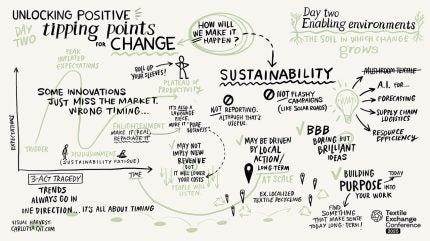
Among the discussions on interventions and enabling environments that can help the industry make progress were how to overcome economic barriers to change and leverage both policy requirements and verification mechanisms that lead to more sustainable systems.
Tariq Fancy, Lecturer in Management at Stanford University’s Graduate School of Business, spoke about the industry being at the beginning of a “mega trend” that is only going in one direction. But to really make progress toward more sustainable systems, we must think long term and look for the “boring but brilliant” ideas that can increase efficiency in areas like supply chain logistics, resource capacity, and the reduction of waste. Crucially, the arguments for adaptation must lean into the numbers and make business sense, repackaged in a way which speaks to the operations and finance teams in their own language.
He challenged us to rethink the structures, mindsets, and policies that currently shape our systems—and dare to redesign them for lasting change.

Discover B2B Marketing That Performs
Combine business intelligence and editorial excellence to reach engaged professionals across 36 leading media platforms.
Then, a conversation moderated by Robin Mellery-Pratt, founding partner of Matter, John Roberts, CEO of Australian Wool Innovation and Vanessa Barboni Hellik, CEO of Another Tomorrow, shared practical strategies for building resilience through deeper collaboration between producers and brands. The discussion emphasised the need to support farmers through volatility, align brand strategies with long-term supply security, and create the enabling conditions for landscape-level change.
Their insights reinforced a clear message: Resilience requires systemic transformation and shared responsibility across the value chain.
The top five takeaways from Textile Exchange Conference Day 2
- Addressing economic barriers is essential to scaling preferred production systems
Economic barriers like high upfront costs, uneven risk, and limited access to finance for producers are slowing the transition needed to close the supply-demand gap, meet climate and nature goals, and safeguard livelihoods. Collective financial responsibility, through long-term contracts, blended finance, and shared investment models, is vital to ease pressure on producers and ensure an equitable shift, particularly at Tier 4 of the supply chain. A shared investment in data collection was also highlighted as critical to provide crucial evidence to peers, brands, investors, and customers that the shift to preferred production systems is a beneficial long-term strategy.
- Regulation is rising—industry must engage, adapt, and lead
The textile sector is increasingly subject to tighter regulation, particularly within the EU. While the EU’s simplification efforts aim to reduce administrative burdens, they also introduce new layers of uncertainty for businesses. In this rapidly changing landscape, proactive policy engagement, close monitoring of legislative developments, and advocacy for standards that enable circular systems are becoming essential business strategies. Panelists discussed how recycled content is critical, but it must be combined with sustainably sourced materials to reduce pressures from textile production, and consumption.
- Landscape-level action requires context-specific insight and collaboration
Delivering impact for climate, nature, people, and animals starts with identifying which materials offer the most potential—and where. Speakers promoted the need to screen material origins, understand regional dependencies, and assess conservation value as critical first steps. Collaboration with local stakeholders is essential to design effective, landscape-level interventions. These actions help prioritise efforts within each organisation’s sphere of influence to support preferred production systems and achieve meaningful outcomes at scale.
- Best practices gain power when they’re verified
Verification is essential for scaling preferred production systems. It strengthens trust and transparency throughout the supply chain, supports credible sustainability claims, and helps stakeholders meet evolving legislative requirements. However, verification must be adaptable, with no one-size-fits-all approach. It must be tailored to context, scale, and purpose.
- To accelerate transition, we must reach the decision makers
Bridging the gap between sustainability goals and actual progress requires more effective engagement with decision-makers across businesses. This involves identifying internal champions to drive ideas forward and tailoring communication to resonate with different stakeholders. A successful approach also requires cross-departmental collaboration and an understanding of the unique priorities and KPIs of teams like legal, finance, and marketing. Panelists discussed how strategy should be twofold: looking at both what’s inside a supply chain and the external factors that influence it.





